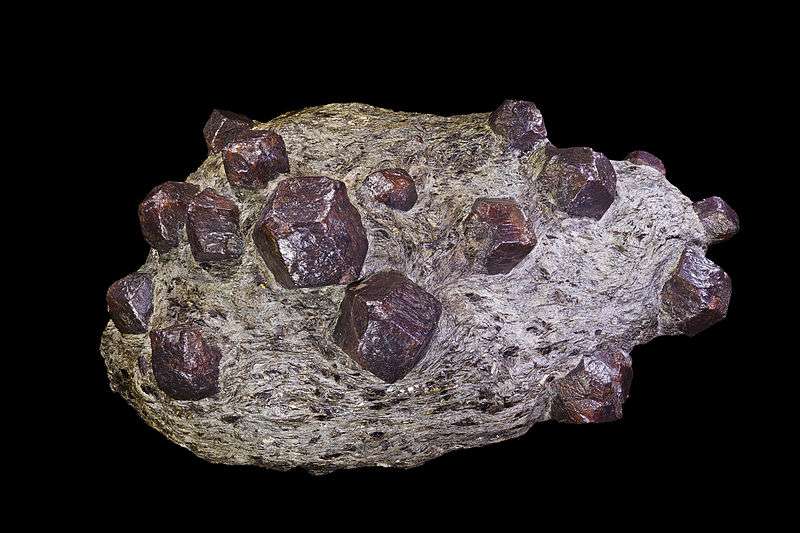
Appearance
Almandine is a deep red, slightly purple-tinged garnet made of iron alumina. It is commonly called carbuncle when it is cut end cabochon, or with a convex face. Viewed through the spectroscope in a bright light, it generally shows three unique absorption bands.
Geographical Distribution
Almandine garnets are distributed throughout the world, appearing on almost every continent. Almandine garnets are distributed throughout the world, appearing on almost every continent. Several prominent areas and nations recognized for their deposits of almandine garnet are Scandinavia, North America, Europe, Asia, Africa, and South America.
History
Almandin, another name for almandite, is a type of mineral that is a member of the garnet family. Alabandical, the name Pliny the Elder gave to a stone discovered or mined at Alabanda, a town in Caria, Asia Minor, is the source of the name corruption.
Metaphysical Properties
Certain belief systems attribute medicinal and metaphysical abilities to garnets, such as almandine. They are thought to encourage balance and happy feelings because they are connected to attributes like passion, vigor, and energy.

Chemical Composition
Almandine’s chemical formula, Fe3Al2(SiO4 )3, denotes that iron (Fe), silicon (Si), aluminum (Al), and oxygen (O) atoms make up its composition. The two main cations in the crystal structure are iron and aluminum. Almandine is a mineral that is a part of the almandine-pyrope solid solution series and is in the garnet group of minerals. This implies that different amounts of iron and magnesium may be present in its structure, which may have an impact on its color.
Types
Within the wider garnet family, which also contains a number of other minerals with various chemical compositions, almandine garnets are categorized as a subgroup. The kinds of cations (metal ions) that are present in garnets’ crystal structures are the main factors used to classify them. Below is a summary of garnet classification:
Pyrope Group
Minerals in the Pyrope Group are mostly composed of magnesium (Mg) and aluminum (Al) cations. The usual color of pyrope garnets ranges from deep red to purplish-red.
Almandine Group
Iron (Fe) and aluminum (Al) cations make up the majority of almandine garnets, as was previously mentioned. Their colors range from crimson to reddish-brown.
Spessartine Group
Manganese (Mn) and aluminum (Al) cations are the distinguishing features of spessartine garnets. They frequently have orange to reddish-orange hues.
Grossular group
The garnets in the grossular group are rich in cations of aluminum (Al) and calcium (Ca). They are colored green, yellow, and brown, among other hues.
Andradite Group
The Andradite Group comprises garnets with cations of calcium (Ca), iron (Fe), or manganese (Mn). They can be seen in shades of brown, black, yellow, and green.
Uvarovite Group
Uvarovite garnets are distinguished by their high chromium (Cr) content, and they are typically green in color.
Uvarovite Group
Uvarovite garnets are usually green in color and stand out for having a high chromium (Cr) concentration.
Uses
Almandine garnets are often used for the following purposes:
- Gemstones: Almandine garnets are frequently used in jewelry as gemstones. They are excellent options for many kinds of jewelry, such as rings, necklaces, earrings, and bracelets because of their deep red to reddish-brown color. They are frequently set in both modern and antique designs and faceted to increase their brilliance.
- Birthstone Jewellery: The traditional birthstone for the month of January is an almandine garnet. As a representation of their birth month, almandine garnet jewelry is worn by many people.
- Industrial Abrasives: Industries including glass cutting, metalworking, and woodworking employ garnets, especially almandine, as abrasive materials.
- To cut through hard materials, they are either ground into abrasive grains or utilized in abrasive waterjet cutting equipment.
- Sandblasting: To clean and prepare surfaces for painting, coating, or finishing, garnet abrasives are utilized in sandblasting applications. They offer a precise and effective abrasive action.
- Semi Precious Beads and Carvings: Almandine garnets are occasionally carved into beads and ornamental objects for use in ornamental art and jewelry-making.
- Historical and Antique Jewelry: Almandine garnets are still highly prized in the vintage and antique jewelry market, having been utilized in historical and ancient jewelry items.
Table





